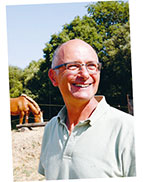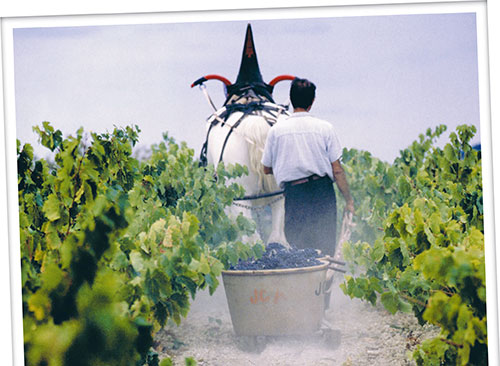

Bernard Bellahsen owns Domaine Fontedicto, a 26-acre (10.5-hectare) farm in the Languedoc, southern France, where he cultivates heritage wheat varieties as well as local terret, grenache, syrah, and carignan grapes. He has farmed organically since 1977, and with horses since 1982.
“You know, it’s a huge advantage working with animals. First off, there’s a real relationship that grows and matures with time.
Then there’s the issue that modern agriculture rapes the earth. It forces it to open regardless of whether or not it is appropriate to do so. When you work beside an animal, it’s totally different. Animals don’t make noise while they work, so you can hear everything that’s going on: the plow on the earth, the earth as it opens. You can feel it too since you’re there and nothing gets in your way. If it’s pouring with rain, your plow will stick and the weight of the sodden earth against the harness will strain your horse. So, you don’t plow, which is perfect since drenched soil is vulnerable to erosion and to nutrients being washed away. Similarly, if the ground is too dry, the plow will skate across its surface. Again, you won’t plow, which is perfect since cutting topsoil open when it’s hot and dry would mean loss of valuable water.
To farm well, farmers ought to consider the state of their soil. They need to work out whether or not it’s the right moment to work the land, and animal traction is a great gauge for this. I guess you could do it with a motorized vehicle but you would have to be extremely sensitive to your surroundings. At least when it’s an animal leading the way, even an idiot can’t get it wrong.
There’s also another advantage. Tractors have combustion engines, whose mini explosions vibrate through the tractor’s wheels into the earth. This constant, rhythmic vibration causes the soil to become more compact—like when you squeeze lentils into a jar. You shake and they slot into place. But this pounding eventually pushes air pockets out of the soil, disrupting the soil life beneath the surface. Soon enough the all-important microorganisms that keep your plants healthy and fed disappear. You have effectively squashed your lentils into place. Horses, luckily, don’t vibrate. Nor do they explode. I didn’t start out working this way but I once watched a farmer ride his horse home at the end of a long day. He lay stretched out on his horse’s back. It was such a touching scene, I inevitably wanted the same.
Until the 1950s, Boulonnais Plough horses, from the Pas-de-Calais in northern France, were used extensively in agriculture. They’re huge, broad animals, with large muscular chests.
Nowadays, though, most end up at the knackers as sausage meat or pie stuffing. Our Cassiopée, luckily, never made it there. We rescued her at five months old and I worked alongside her for fourteen years. We plowed, harvested, transported, lived side by side, for seven or eight hours a day, weekends included. When you spend that much time together, trust builds and the result is magical. She’d get on with things by herself, no prompting needed. It was extraordinary.
As men, we’re not above it all, even though we might think we are. A farmer perched up high in his air-conditioned, automated, glass cabin has a skewed perspective. He’s detached. The farmer working with his plow horse, on the other hand, is in the thick of it. He is totally dependent on his companion’s strength. He is grounded, literally, since his feet are connected directly with the earth. He sees the state of his land and what needs to be done. He also sees his plants and sees them from a different angle. He is not above but below, or rather inside. He’s part of the environment and he feels it.
Working alongside a horse makes you humble. It forces you to listen, to try to work in harmony with your surroundings, and to look at things differently. I can’t recommend it enough.”

Bernard Bellahsen and Cassiopée harvesting at Domaine Fontedicto in 2000.